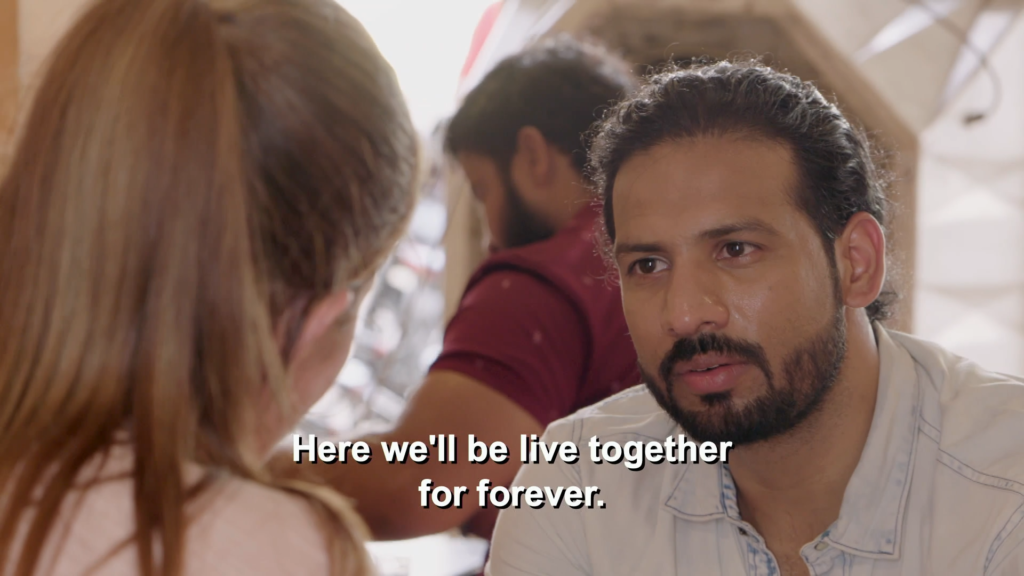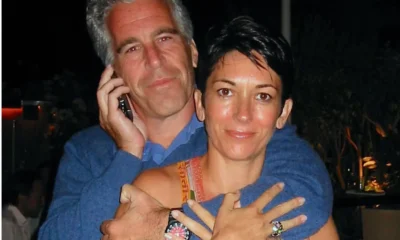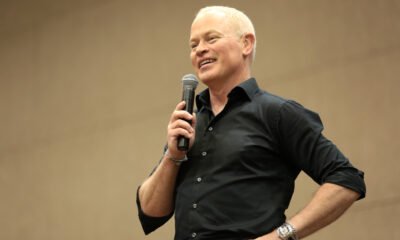Entertainment
Jen Boecher Exposes Rishi Singh After Breakup Announcement: He’s Lying to 90 Day … on November 6, 2023 at 9:18 pm The Hollywood Gossip

Back in May, Jen Boecher and Rishi Singh seemed to be on different pages in their relationship. That pattern continues.
The 90 Day Fiance: The Other Way couple were still together earlier this year. Now, they’ve broken up.
Over the weekend, Rishi announced their split, saying that it was a mutual breakup and that they remain friends.
Jen says that, actually, that’s not the truth. It wasn’t a mutual split. The “still friends” claim is debatable. And Rishi has since begun dating someone else … desperate to return to 90 Day Fiance.
Jen Boecher and Rishi Singh had a difficult, emotional parting during their season. (Image Credit: TLC)
Though Jen Boecher and Rishi Singh didn’t exactly have an explosive storyline on 90 Day Fiance: The Other Way Season 4, they had major ups and downs.
Communication was a factor. Or a lack thereof.
Most of all, Rishi seemed torn and unable to fully commit to pleasing his family or being with Jen, whom he loved. He wanted the best of both worlds.
On the Tell All, Jen Boecher and Rishi Singh were still together, but it wasn’t very clear cut. (Image Credit: TLC)
During the Tell All, things were … better. They didn’t seem totally clear on the status of things or their future, but they weren’t exes.
(In fact, memorably, 90 Day Fiance fan favorite Debbie Aguero wanted to fix Jen up with her adult son, Julian. And Jen did give him her number … just to keep her options open)
Still, fans have pretty much assumed that they were still together, albeit over long distance. Until Friday, November 3, however.
In early November 2023, Rishi Singh took to Instagram to share a text post with 90 Day Fiance fans. He and Jen Boecher had broken up. (Image Credit: Instagram)
“Jen and I have mutually decided to part ways,” Rishi wrote in a text post late last week.
“This hasn’t been an easy decision by any measure,” he continued. “But we know it’s the right one at this point in our lives.”
Rishi concluded: “The love and respect we have will always be, and our shared memories are forever. We part as life partners, but will remain platonic friends.”
90 Day Fiance: The Other Way Season 4 star Rishi Singh shared this photo featuring Jen Boecher at the very end of April in 2023. (Photo Credit: Instagram)
That seems like a very normal breakup announcement. But you’d normally expect them both to post it, or to each post their own version.
Or at least a “like” from Jen, since they’re allegedly still friends.
Instead, Jen took to Instagram Live and then, later, to her Instagram Story to clear things up. Because she says that Rishi is lying about just about everything.
After her recent ex announced their breakup, Jen Boecher took to Instagram Live to share her side of the story. (Image Credit: Instagram)
So, according to Jen, she broke up with Rishi a few months ago. It was not mutual.
Rishi loved her, she said, and was finally ready to commit. But after years of waiting, her love for him had begun to wither.
Jen affirmed that the two were still somewhat friendly — but not in regular contact. Friendly doesn’t always mean friends.
Even though things were mostly good during the Tell All, Jen Boecher felt a lot of emotions. That’s normal! (Image Credit: TLC)
Jen had even more to say. And this is where things go beyond a weird, unilateral breakup fib.
According to her, Rishi had very recently reached out to her to tell her that he was with someone else … who was planning to come visit him.
Apparently, the new woman had appeared in some capacity on 90 Day Fiance in the past. And Rishi hoped to become engaged to this new gal on a future season of 90 Day Fiance. Ouch!
In a lengthy text post, Jen Boecher summarized her side of things for those who had missed her Instagram Live. Her November 2023 had a rough start. (Image Credit: Instagram)
There was more. Jen said that she found out that Rishi had been gossiping about her behind her back with other cast members from the show. That’s a betrayal.
Though Jen doesn’t regret the relationship, she did feel hurt by his actions. His plans to return to the show with a new gal also stung.
That said, Jen hasn’t ruled out returning to the franchise on 90 Day: The Single Life. Many of us would enjoy watching her find happiness.
Jen Boecher Exposes Rishi Singh After Breakup Announcement: He’s Lying to 90 Day … was originally published on The Hollywood Gossip.
Back in May, Jen Boecher and Rishi Singh seemed to be on different pages in their relationship. That pattern continues. …
Jen Boecher Exposes Rishi Singh After Breakup Announcement: He’s Lying to 90 Day … was originally published on The Hollywood Gossip.
The Hollywood Gossip Read More
Entertainment
What We Can Learn Inside 50 Cent’s Explosive Diddy Documentary: 5 Reasons You Should Watch

50 Cent’s new Netflix docuseries about Sean “Diddy” Combs is more than a headline-grabbing exposé; it is a meticulous breakdown of how power, celebrity, and silence can collide in the entertainment industry.
Across its episodes, the series traces Diddy’s rise, the allegations that followed him for years, and the shocking footage and testimonies now forcing a wider cultural reckoning.

1. It Chronicles Diddy’s Rise and Fall – And How Power Warps Reality
The docuseries follows Combs from hitmaker and business icon to a figure facing serious criminal conviction and public disgrace, mapping out decades of influence, branding, and behind-the-scenes behavior. Watching that arc shows how money, fame, and industry relationships can shield someone from scrutiny and delay accountability, even as disturbing accusations accumulate.

2. Never-Before-Seen Footage Shows How Narratives Are Managed
Exclusive footage of Diddy in private settings and in the tense days around his legal troubles reveals how carefully celebrity narratives are shaped, even in crisis.
Viewers can learn to question polished statements and recognize that what looks spontaneous in public is often the result of strategy, damage control, and legal calculation.
3. Survivors’ Stories Highlight Patterns of Abuse and Silence
Interviews with alleged victims, former staff, and industry insiders describe patterns of control, fear, and emotional or physical harm that were long whispered about but rarely aired in this detail. Their stories underline how difficult it is to speak out against a powerful figure, teaching viewers why many survivors delay disclosure and why consistent patterns across multiple accounts matter.
4. 50 Cent’s Approach Shows Storytelling as a Tool for Accountability
As executive producer, 50 Cent uses his reputation and platform to push a project that leans into uncomfortable truths rather than protecting industry relationships. The series demonstrates how documentary storytelling can challenge established power structures, elevate marginalized voices, and pressure institutions to respond when traditional systems have failed.
5. The Cultural Backlash Reveals How Society Handles Celebrity Accountability
Reactions to the doc—ranging from people calling it necessary and brave to others dismissing it as a vendetta or smear campaign—expose how emotionally invested audiences can be in defending or condemning a famous figure. Watching that debate unfold helps viewers see how fandom, nostalgia, and bias influence who is believed, and why conversations about “cancel culture” often mask deeper questions about justice and who is considered too powerful to fall.
Entertainment
South Park’s Christmas Episode Delivers the Antichrist

A new Christmas-themed episode of South Park is scheduled to air with a central plot in which Satan is depicted as preparing for the birth of an Antichrist figure. The premise extends a season-long narrative arc that has involved Satan, Donald Trump, and apocalyptic rhetoric, positioning this holiday episode as a culmination of those storylines rather than a stand‑alone concept.
Episode premise and season context
According to published synopses and entertainment coverage, the episode frames the Antichrist as part of a fictional storyline that blends religious symbolism with commentary on politics, media, and cultural fear. This follows earlier Season 28 episodes that introduced ideas about Trump fathering an Antichrist child and tech billionaire Peter Thiel obsessing over prophecy and end‑times narratives. The Christmas setting is presented as a contrast to the darker themes, reflecting the series’ pattern of pairing holiday imagery with controversial subject matter.
Public and political reactions
Coverage notes that some figures connected to Donald Trump’s political orbit have criticized the season’s portrayal of Trump and his allies, describing the show as relying on shock tactics rather than substantive critique. Commentators highlight that these objections are directed more at the depiction of real political figures and the show’s tone than at the specific theology of the Antichrist storyline.
At the time of reporting, there have not been widely reported, detailed statements from major religious leaders focused solely on this Christmas episode, though religion-focused criticism of South Park in general has a long history.
Media and cultural commentary
Entertainment outlets such as The Hollywood Reporter, Entertainment Weekly, Forbes, Slate, and USA Today describe the Antichrist arc as part of South Park’s ongoing use of Trump-era and tech-world politics as material for satire.
Viewer guidance and content advisory
South Park is rated TV‑MA and is intended for adult audiences due to strong language, explicit themes, and frequent use of religious and political satire. Viewers who are sensitive to depictions of Satan, the Antichrist, or parodies involving real political figures may find this episode particularly objectionable, while others may view it as consistent with the show’s long‑running approach to controversial topics. As with previous episodes, individual responses are likely to vary widely, and the episode is best understood as part of an ongoing satirical series rather than a factual or theological statement.
Entertainment
Sydney Sweeney Finally Confronts the Plastic Surgery Rumors

Sydney Sweeney has decided she is finished watching strangers on the internet treat her face like a forensic project. After years of side‑by‑side screenshots, “then vs now” TikToks, and long comment threads wondering what work she has supposedly had done, the actor is now addressing the plastic surgery rumors directly—and using them to say something larger about how women are looked at in Hollywood and online.

Growing Up on Camera vs. “Before and After” Culture
Sweeney points out that people are often mistaking normal changes for procedures: she grew up on camera, her roles now come with big‑budget glam teams, and her body has shifted as she has trained, aged, and worked nonstop. Yet every new red‑carpet photo gets folded into a narrative that assumes surgeons, not time, are responsible. Rather than walking through a checklist of what is “real,” she emphasizes how bizarre it is that internet detectives comb through pores, noses, and jawlines as if they are owed an explanation for every contour of a woman’s face.
The Real Problem Isn’t Her Face
By speaking up, Sweeney is redirecting the conversation away from her features and toward the culture that obsesses over them.
She argues that the real issue isn’t whether an actress has had work done, but why audiences feel so entitled to dissect her body as public property in the first place.
For her, the constant speculation is less about curiosity and more about control—another way to tell women what they should look like and punish them when they do not fit. In calling out that dynamic, Sweeney isn’t just defending herself; she is forcing fans and followers to ask why tearing apart someone else’s appearance has become such a popular form of entertainment.

 Entertainment2 weeks ago
Entertainment2 weeks agoWicked Sequel Disappoints Fans: Audience Verdict on For Good

 News4 weeks ago
News4 weeks agoYolanda Adams Questions Traditional Views on God’s Gender, Audience Reacts

 Entertainment2 weeks ago
Entertainment2 weeks agoAriana & Cynthia Say They’re in a ‘Non‑Demi Curious, Semi‑Binary’ Relationship… WTF Does That Even Mean?

 News3 weeks ago
News3 weeks agoEpstein Files to Be Declassified After Trump Order

 News4 weeks ago
News4 weeks agoTrump Throws Epstein Files at Clinton’s Door

 Entertainment4 weeks ago
Entertainment4 weeks agoAriana Grande’s Red Carpet: When Fans Forget Boundaries

 Entertainment4 weeks ago
Entertainment4 weeks agoHollywood’s Kiss or Miss Policy: Why Saying No Got Neal McDonough Blackballed

 Entertainment3 weeks ago
Entertainment3 weeks agoJimmy Cliff, Reggae Legend and Star of ‘The Harder They Come,’ Dies at 81



























sklep
March 27, 2024 at 10:08 am
I see You’re truly a just right webmaster. This website loading pace is
amazing. It sort of feels that you’re doing any distinctive trick.
Moreover, the contents are masterwork. you have done a
great process in this matter! Similar here: dobry sklep and also here: Najtańszy sklep